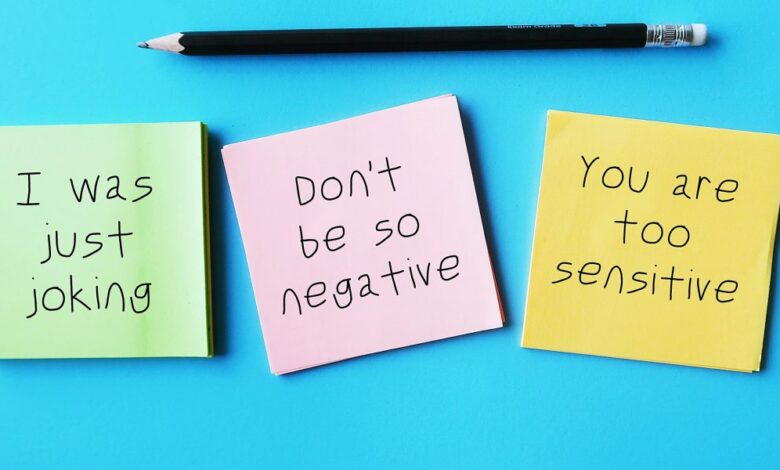Gaslighting: What it is and how to spot it


Once reserved for the psychologist’s office, the term “gaslighting” has eased its way into the public vernacular.
A form of emotional abuse in which a perpetrator forces the victim to question their reality, gaslighting can leave victims feeling confused, isolated, and insecure.
The concept derives from a 1930s play and subsequent film Gas Light in which a husband manipulates his wife into doubting her memory by changing the intensity of their gas lamps. There is no one moment the term became part of our everyday language, but it entered the mainstream in the mid-2010s amid the 2016 political election and the rise of the #MeToo Movement, which brought attention to more subtle forms of abuse and violence against women. By 2018, gaslighting was a buzzword. By 2022, gaslighting became Merriam-Webster’s “word of the year,” after the pandemic era rise of “fake news,” deep fakes, and conspiracy theories sparked a 1,740% increase in search for the term.
Its ascent coincided with the rise in therapy speak, in which we’ve seamlessly integrated mental health jargon into our conversations—a result of societal reckonings like the Black Lives Matter movement, plus the destigmatization of therapy among younger generations. But the problem with gaslighting’s popularity is that it can be too loosely thrown around, says Robin Stern, Ph.D., psychoanalyst and author of The Gaslight Effect: How to Spot and Survive the Hidden Manipulation Others Use to Control Your Life. She originally published her book in 2007, but re-released it in 2018 given how widespread the term had become.
“People were using it all the time and misusing it, because gaslighting is not the same thing as disagreeing,” Stern tells Fortune. “People have disagreements and disagreements are good, it helps you define your boundaries. But gaslighting is trying to undermine somebody else’s reality and assert your own. It’s very different.”
Though commonly used to describe psychological abuse between romantic partners, Stern said gaslighting can occur in parent-child and manager-employee relationships as well.
Four psychologists broke down the three most common ways gaslighting might present itself, and what to do if you spot a gaslighter in your home or office.
In a relationship, a partner might gaslight the other in subtle ways that are difficult to identify in isolation, but build up over time.
What makes gaslighting different—and at times more insidious—than other forms of emotional manipulation is its subtlety, says Paige Sweet, an assistant professor of sociology at the University of Michigan who studies gaslighting. Though some abuses, such as bullying, are easy to identify, victims may not recognize they are being gaslit right away, because the partner will warp their sense of reality. One partner might rightly accuse the other of cheating, but the perpetrator might gaslight their partner by accusing them of being jealous, possessive, or even unfaithful.
A common instance where gaslighting comes up is after a fight, when a victim might bring up something the gaslighter said that upset them and the perpetrator responds by denying he or she said that at all, says psychotherapist Dori Gatter. A perpetrator of gaslighting might also tell the victim they are “too sensitive,” “overreacting,” or “being dramatic” as a way to invalidate his or her feelings.
Usually, perpetrators will further damage a victim’s credibility by painting them as “crazy” to friends and family, Sweet adds.
“Abusers will attack victims’ credibility in sort of shared networks [with statements like] ‘she’s crazy’ or ‘she’s trying to make me look bad in the divorce,’” she explains. “It’s really flipping the script among friends and family, even in front of police and in front of judges.”
The key to identifying gaslighting is by spotting repeated instances occurring over time, Sweet says, perhaps by keeping a written log of times when the victim felt confused or misled or by talking out their partner’s behavior with someone else. Though a gaslighter could want to seek therapy and change their behavior to salvage the relationship, Gatter said the best thing to do when a victim realizes they are in an abusive relationship is to get out.
“Gaslighting is so hard to recognize,” Sweet says. “People use the language of ‘twilight zone’ when they describe gaslighting relationships—he sense that things are wrong or bad, but you can’t really put your finger on it.”
Parents might gaslight their children to assert their dominance and seek control.
Gaslighters isolate their victim to get power or control over them, explains Stephanie Sarkis, author of Gaslighting: Recognize Manipulative and Emotionally Abusive People—and Break Free. Perpetrators might have grown up in a family where parents had this pathological behavior, and then replay the same dynamics with their own children, she says.
“They’ll do something called triangulating, where you pit people against each other,” she says. This might play out when parents divide their children into the “golden child,” who can do no wrong, and the “scapegoat child,” who can do no right. Dividing children up, to where they sometimes grow up resenting each other, makes it easier to control and manipulate each kid.
A parent might assert their control over a teenager by warping their sense of self or self image. Stern says if a mother fears her daughter attending a concert, she might gaslight her teenager by telling her things like “nice girls like you don’t go to those kinds of places,” instead of a straightforward “no.” In turn, the young person would begin to question their own judgment and struggle to distinguish between what their parent wants versus what they themselves want.
Gaslighting parents are also often not consistent with their rules, Sarkis added, as one day a child might get in trouble for something that had previously never been a problem. This pattern leads to confusion, especially for young children, who then question whether their actions are right or wrong.
Sarkis said children who spot gaslighting behavior in their parents might not have the resources or safety to speak up, meaning it’s up to the co-parent to identify the patterns and ask the perpetrator to seek counseling.
Gaslighters at work will rarely give their employees accolades, and might belittle their feelings of being discriminated against.
Spotting a gaslighter at work might mean being on the lookout for a narcissist, or someone with an excessive desire for attention and inflated sense of self, Gatter says. Since aspects of being a narcissist—including high self worth—are beneficial in the workplace, gaslighting narcissists might be very successful high performers.
Gatter said a narcissistic boss will rarely give their employee accolades and won’t be open to trying a new way to complete a task or a project. Many micromanagers gaslight, Gatter adds, as a way to bring up all the little things the employee did incorrectly, despite the many wins he or she might have.
Sweet says social hierarchies can also play a role in gaslighting, as typically a person from the dominant demographic will abuse a marginalized one. This is particularly salient in the workplace, the sociologist says, where someone might experience racial discrimination: When an employee of color confronts their boss about a microaggression, the manager might gaslight them by telling them they’re “being sensitive” or pointing to the company’s commitment to diversity, equity, and inclusion.
Confronting a gaslighter at work is tricky, psychologists say, as they aren’t going to be receptive to criticism. Gatter said an employee could try bringing up a documented list of instances to the human resources department, but they could risk retaliation from their manager.
“So you have a choice in that situation, which is suck it up and deal with it or look for another job, but this won’t ever be a boss that you can have a good relationship with,” she adds. “They’re not interested in a good relationship.”
Source link




